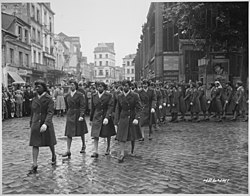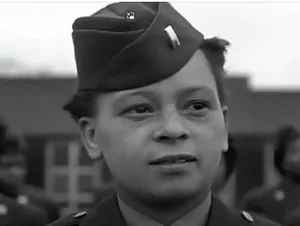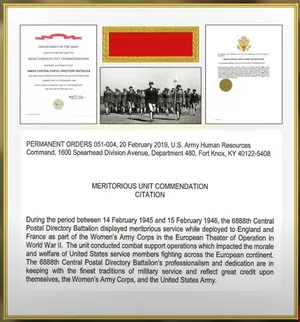
The first all-Black female unit in World War II is better known as the 6888th Central Postal Directory Battalion[1] or the Six Triple Eight[2]. Under the command of Major Charity Adams[3], this unit was part of the Women's Army Corps (WAC)[4]. Formed and assigned due in part to the collaborative efforts of First Lady Eleanor Roosevelt[5], Mary McLeod Bethune[6], and the Black Cabinet, the Army unit altered the morale of the entire nation.
Research your ancestors on MyHeritage
Their commanderTheir commander

Graduating as valedictorian from her South Carolina High School, Charity Adams was driven. With a bachelor's degree in mathematics and physics from Wilberforce University in 1938 she already defied the typical stereotype. The timing was perfect because during World War II, Mary McLeod Bethune pressured the Secretary of War to commission Black women as officers of the (WAAC) Women’s Army Auxiliary Corps, later called (WAC) Women’s Army Corps. Bethune worked with Oveta Culp Hobby[7] to select the women that would make up 10% of the total candidates selected. A graduate of Officer Candidate School at Fort Des Moines, Iowa in 1942, Adams would become one of those identified and selected, ultimately making her the first Black officer to receive a commission in the WAAC.
The history changing assignmentThe history changing assignment
Back then mail call was a vital part of military service, with the Birmingham, London warehouses filled to the brim with letters, care packages and Christmas gifts from home, it seemed an impossible task. So backlogged was the system that the morale of soldiers and their loved ones plummeted because neither had heard from the other in a very long time. This frayed the resolve of even the most dedicated soldier and brought the national morale to an all-time low. Initially, the Army had no intentions of deploying African American women overseas but a number of unsuccessful attempts to solve the bottleneck mail problem had already been made. With lots of opposition, finally, the 6888th was formed and in February 1945 sent to Europe to solve the problem.
Tackling the jobTackling the job
Hindered at every turn with deplorable working conditions, an unrealistic deadline and lack of military support, the hope was of failure which would fortify racist stereotypes claiming lack of intelligence and overall inferiority to ultimately toss the women out of the military. Already a proven leader and achiever, Adams recognized the importance of the unit’s role in World War II for women and Blacks and that the stakes were high.
With racism rearing its head at every corner, from the bombed-out facility to be used as headquarters and barracks for the women; to the lack of heat; and their non-military status, the unit was met with obstacles every step of the way. Add that to letters with inadequate addressing and illegible handwriting, in the beginning, much of the mail was returned, undeliverable. Adams called upon the ingenuity of her troops to help solve their numerous problems. Developing a strategy that included a new tracking system and greater efficiency they were able to process 65,000 pieces of mail per shift. Fully driven to complete the job, their motto was “No Mail, Low Morale.”
The outcomeThe outcome
Working three, eight-hour shifts, seven days a week, they completed their task ahead of schedule. Their success was not only in their ability to clear the mail backlog in just three months but also breaking racial and gender barriers within the military. Their legacy in the war effort proved racial stereotypes to be inaccurate and wholly unjustified and also that women could perform jobs traditionally held by men.
The 6888th's dedication and hard work should have skyrocketed them to the top giving them the recognition and respect they deserved. Unfortunately, there were no ticker tape parades or other recognition for the major role they played in the war. Regrettably, throughout mainstream American history, the successes of African Americans have been grossly overlooked.
Newspapers help tell the storyNewspapers help tell the story
Not a household name, examining newspapers, especially historic newspapers by and for African Americans help to tell the story. The African American published in Baltimore, Maryland provides information on the journey of the 6888th, calling out their successes and often naming individuals. The issue dated April 20, 1943 boasted a headline, “Four Companies of WAACs Needed for Service Abroad”. Identified were the 8th, 10th, 18th and 20th companies under the command of 1st Officer Charity Adams of Columbia, South Carolina. Also identified in the article are 2d Officer Sarah Emmert of Chicago, Illinois; 2d Officer Sarah Murphy of Atlanta, Georgia; and 2d Officer Geneva Ferguson of Camp Dennison, Ohio.
On June 26, 1943, the paper printed photographs of members of the 6888th who were promoted to 2d Lieutenant and their home towns, offering specific recognition. Three of the nine pictured nine were Corrine E. Walker of Baltimore, Maryland; Mercedes Jordan of New York City and Virginia Moore of Honor, Michigan.
The October 16, 1943, Columbia, South Carolina Palmetto Leader reported Adams’ promotion to Major which it said was announced September 20th. General Omar N. Bradley, Army Chief of Staff was quoted in the November 4, 1948, Veteran News column of the Oklahoma Eagle that “Not only have the women demonstrated for more than five years that they have a distinctive to make to the success of the Army, but the plain fact is we need them badly.” “We can no longer overlook the lesson that business and industry have taught us that there are some jobs women can do better than men.”
Important moments following the success of the 6888thImportant moments following the success of the 6888th

- In 1948, President Harry S. Truman signed Executive Order 9981[8], which mandated the desegregation of the armed forces.
- In 1948, the Women's Armed Services Integration Act[9] allowed women to serve as permanent, regular members of the armed forces, rather than just in temporary wartime roles.
- In 2013, the Pentagon lifted the ban on women serving in combat roles, allowing them to serve in front-line positions.
- In 2019, the U.S. Army approved the Meritorious Unit Commendation Citation[10] to the 6888th.
- In 2023, Virginia’s Fort Lee which was named for the Confederate General, now it bears the name Ft. Gregg-Adams in honor of Lt. Gen. Arthur Gregg[11] and Lt. Col. Charity Adams.
Notable names in the success of the 6888thNotable names in the success of the 6888th
See alsoSee also
Explore more about Women's Army Corps: The Six Triple EightExplore more about Women's Army Corps: The Six Triple Eight
- United States military records collection at MyHeritage
- The 6888th Central Postal Directory Battalion. Army Women’s Foundation
- The 6888 Postal Directory Battalion - Heroes of World War II. Making History Channel
- All-Black Female WWII Unit to Receive Congressional Gold Medal. DOD News, U.S. Department of Defense, March 18, 2022
- Colonel Charity Adams: 6888th Commanding Officer. The National WWII Museum. New Orleans
- In World War II, Black Women’s Army Unit Delivered. American Postal Workers Union
- Niece of late WWII veteran honored with Congressional Gold Medal, seeks state recognition. PBS
- ‘Black Rosies’: The Forgotten African American Heroines of the WWII Homefront. History.com.
- Honey, Maureen. Bitter Fruit: African American Women in World War II. Columbia: University of Missouri Press, 1999.
- Fort Lee is renamed Fort Gregg-Adams to honor 2 pioneering Black officers. NPR
- The Story of Black Rosies and Their Pioneering Role in WWII. Ancestral Findings Podcast. Accessed January 7, 2025.
- Charity Adams Earley. National Park Service.
- Sisters in War. Dog Ear Publishing, LLC. 2008.
- Sorting the Mail, Blazing a Trail: African-American Women in World War II. U. S. Department of Defense. 2017.
- Silvera, John D., compiler. The Negro in World War II. Arno Press, New York, 1969.
- Millie Dunn Veasey. National Park Service
- In 75 Years Since Women's Armed Services Integration Act, Female Service Members Have Excelled. DOD News, June 12, 2023.
- Films at AAMP: Invisible Warriors: African American Women in World War II. African American Museum in Philadelphia
- Tuesday Explorers presents Invisible Warriors: African American Women in World War II. AARP Virginia
- National Archives. "No Mail, No Morale: The 6888th Central Postal Battalion." The Unwritten Record. Last modified February 8, 2022. Accessed on April 6, 2025.
References
- ↑ 6888th Central Postal Directory Battalion (Women's Army Corps). U.S. Army Center of Military History
- ↑ The Six Triple Eight | Official Trailer | Netflix
- ↑ Charity Adams-Earley. National Museum of the United States Army
- ↑ Creation of the Women's Army Corps. U.S. Army
- ↑ Eleanor Roosevelt Biography
- ↑ Mary McLeod Bethune. National Women's History Museum
- ↑ Oveta Culp Hobby. National Museum of the United States Army
- ↑ Executive Order 9981, Desegregating the Military
- ↑ Women’s Armed Services Integration Act. Encyclopedia Britannica
- ↑ Understanding the Meritorious Unit Commendation: A Military Honor. Total Military Insight
- ↑ Celebrating the career of retired Lt. Gen. Arthur J. Gregg. United States Army

